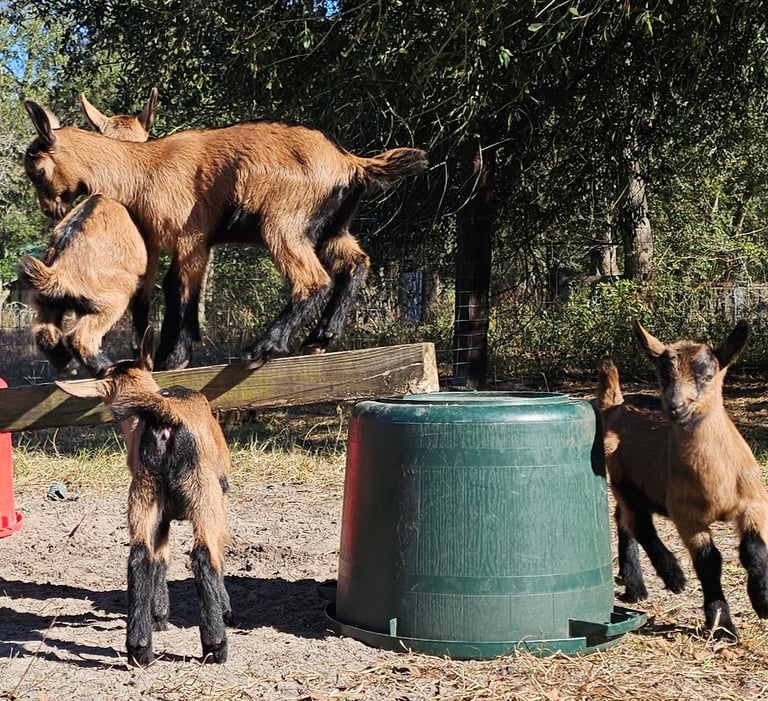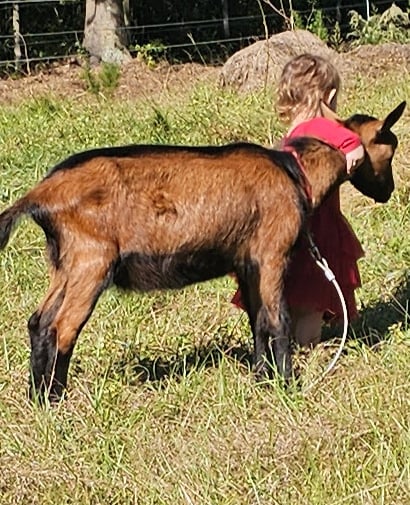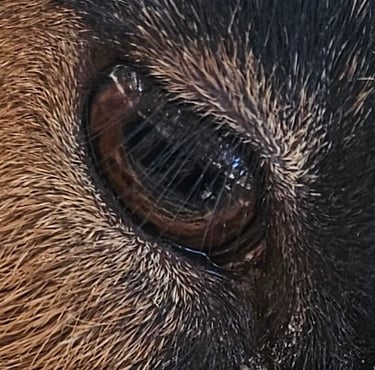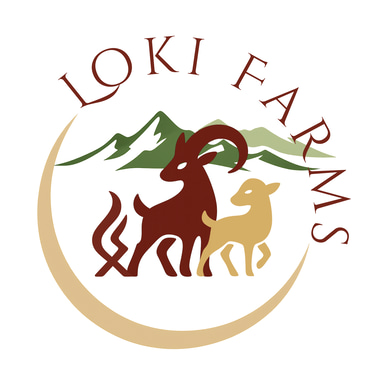At Loki Farms, we milk twice a day not before dawn (though that's likely changing next year to make it to the market early,) and sometime later in the evening where we can fit it into our schedule with chores, kids, and dinner that day. It’s calm work, a nice slow end to the day. The goats greet us at the gate with their familiar voices and gentle curiosity. Each one has a personality: Daisy’s hollering at the gate to get us moving because she thinks we're always late, Iris' patience, Tilly’s eagerness for a snuggle. It's a nice, usually peaceful, way to begin and end the day.
Goats also bring humor and joy in a way few other animals can. They’re playful, clever, and full of personality. The kids run, climb, and balance on anything they can find. Logs, stumps, feeders, while the adults play lazy headbutt games on cool afternoons. They’re interactive animals; they make eye contact, respond to your voice, and often come looking for scratches or a tug on your shirt sleeve just to say hello.


For families looking to start small, goats are wonderfully scalable. Two well-bred standard size does can easily provide enough milk for a household. One to milk, one to carry a pregnancy and you can alternate them year by year to keep milk flowing through the seasons. For those looking to go bigger, the same setup scales beautifully: more goats mean more milk, cheese, soap, or sales. We’re currently expanding from three to six milkers and plan to reach ten in milk as we grow.
And best of all, goats fit around real life. They’re flexible animals that work with your schedule instead of ruling it. If you have a busy season or need to take a break, you can milk once a day instead of twice without harm. If you’re kid-sharing, you can still take weekends off, just separate the kids overnight, milk in the morning, and let them nurse during the day. It’s easy to adjust, leave for a short trip, or just skip a milking when life gets hectic.
And despite what people say, they’re not nearly as troublesome as expected. Ours respect their four-foot fences and have never been the escape artists people warn about. They don’t eat everything. In fact, they’re quite selective grazers. And the milk? Nothing “goaty” about it. Most people who think they don’t like goat milk have only tried store-bought, which can come from stressed or mineral-deficient animals. Fresh, well-balanced goat milk from healthy animals is mild, creamy, and clean. Often better than cow’s milk.
For us, goats are more than just livestock, they’re a partnership. They’ve made this dream of self-reliance possible, one jar of milk at a time. Whether you’re looking for fresh milk for your family, independence from the grocery store, or a gentle step into farming, goats are a wonderful place to start.
For us, goats began as a way to feed our family and live more independently, but like most good things, it grew. Once you’ve seen what a few good does can do, it’s hard not to imagine what ten could accomplish. The next step was turning that rhythm into something lasting. A herd that could provide milk for others, build a reputation for quality, and support our family in return. That’s when registration became more than paperwork, it became part of our plan to make Loki Farms something that lasts.
Goats are a perfect fit for small farms and homesteads. They don’t need endless pasture or specialized equipment. Just good hay, clean water, shelter, and appropriate loose minerals. They give back in spades: milk, soap, cheese, butter, and enough "cool" manure to keep any garden thriving. For many families, goats are the easiest way to gain a real measure of independence. Fresh milk you don’t have to buy, healthy protein if you're open to that, and a reason to step outside and breathe for a bit every day. I love just going out and sitting in their pen at times. They all usually come up for scratches and to just hang.
We chose goats because they were practical. Cows are wonderful, but they produce more milk than most families could ever use themselves, require heavy-duty fencing, take up more space than we wanted to dedicate, and the feed bill would be much higher. Sheep, another good option, can make incredible cheese, but their lactations are shorter, their yield smaller, and they can be more fragile in our humid climate. Goats hit the balance point. Productive without being overwhelming, sturdy without being hard on the land.
Why Goats?
Why Start With Registered
When we started with goats, the goal was simple: milk for our family and a step toward self-reliance. But the deeper we got into breeding and improving our herd, the more we realized how much tracking and lineage matter. Registration isn’t just about paperwork it’s about purpose.
For a small farm, or even a homestead focused on sustaining only itself, registered goats are a smart investment. They sell faster, to a wider audience, and at higher prices. There is an overabundance of goats on the market. If they're not registered, they either don't sell, or sell for a fraction of what they're worth. Having your goats registered with a breed registry, you aren't getting stuck with more animals than you intended, or having to make the hard choice to take them to a sale barn, use them for meat, or resign to feeding all those extra mouths for life. You're giving them the best chance to go to a good home where they can be productive long term. When people buy registered stock, they know what they’re getting, and are willing to pay more for it. They're getting a goat with a known pedigree, predictable production, and traceable genetics. That transparency builds trust. It also builds reputation, which is priceless when you’re planning to turn your herd into part of your family’s income.
Registration also helps us measure progress. We can track milk yield, structure, udder attachments, and temperament over generations. It gives us another way to pair animals intentionally, not just by appearance or convenience, but by data and results. When we look back at our herd records, we can see where each improvement came from: stronger legs, better milk flavor, smoother foreudders. That’s the kind of refinement that happens when you know your starting point.
There’s also a sense of accountability and stewardship that comes with working inside a registered herd. These animals carry the history of the Oberhasli breed, decades of careful breeding and selection. Keeping records, submitting registrations, and improving each generation isn’t about chasing ribbons; it’s about preserving and continuously improving something worth keeping.
And, simply put, registered goats make business sense. They hold value better, appeal to both homesteaders and other breeders, and open doors for growth, milk testing, linear appraisal, and genetic performance programs. They’re not just part of a farm; they’re part of a legacy.
For us at Loki Farms, registration ties everything together: the heart of homesteading, the science of breeding, and the future of a small family business built on trust and quality.
Once we knew we wanted to build a herd with real staying power, the next question was: which breed? There are dozens of dairy goats to choose from, but one stood out to us from the beginning. Not just for its looks, though they are pretty, but for their balance, temperament, and its milk.
Whichever way you decide is right for you, let me just impart this one thing. Start with bottle raised. Dam raised can be hard to tame if they've not been handled, but bottle babies will be in your pocket. Which might be annoying at times, but it really makes them so much easier to handle and train if they already trust you.
Why Oberhasli
When we started searching for the right dairy breed, we wanted milk that tasted close to cow’s milk. Smooth, clean, and naturally sweet. The Oberhasli’s reputation for mild flavor is what caught our attention first. After milking our own, we think that reputation undersells it. Oberhasli milk isn’t just similar to cow milk, it’s better. It’s lighter, crisper, and has no “goaty” aftertaste, as long as we keep up with minerals. Even on hot days or after chilling. Gem and Iris, two of our does, consistently give milk so fresh and mild it’s nearly indistinguishable from cream-top cow milk straight from the bottle.
The production is nothing to shrug at either. One of our foundation does, Daisy, peaks at nearly a gallon and a half a day, with Gem holding steady at about a gallon, and Iris, as a yearling first freshener, coming in around three-quarters of a gallon daily. That’s more than enough for a family’s daily use and still leaves room for cheesemaking, soap, and bottle babies.
But where this breed truly shines is its disposition and manageability. Every Oberhasli we’re keeping has been level-headed, calm, and easy to work with. They respect fences, tolerate handling, and adjust quickly to changes in feeding or routine. Axel, our senior buck, is a gentle giant, strong and thick-boned, but patient enough to let toddlers pet him even during rut. The does are much the same: curious but not pushy, and surprisingly patient when it comes to milking and hoof trimming.


We’ve also found them remarkably hardy and low-maintenance. Parasite issues are minimal, hoof rot hasn’t been a problem (even in wet seasons), and they’ve handled the Southern Georgia heat and humidity very well. They’re easy kidders, attentive mothers, and rarely need intervention. They thrive when given the basics, food, water, shelter, and balanced minerals, and then largely left to do what they do best.
Here at Loki Farms, we’re steadily shaping our Oberhasli line toward our ideal:
A sturdy, more substantial frame like Axel’s, paired with Daisy’s long dairy body
Wide, level hindquarters like Tilly and Tails
High, well-attached udders with smooth, pocket-free foreudders that should pass down from Tails' lineage.
Hard, clean feet, good feed conversion, and efficient metabolism like Axel
Sweet, clean-tasting milk Like Iris and Gem with strong production and longevity like Daisy
And above all, Axel’s patience and gentleness. The kind of temperament that makes them safe for our children and a joy to handle. They can be the perfect goat in every other way, but if they have a poor attitude, it can just ruin the day and cause stress.
Oberhasli goats fit the rhythm of our farm really well. They’re beautiful, sensible, and quietly reliable. Goats that do their job without fuss and make every day a little easier.
Our Mission Going Forward
Our goal is simple: raise goats that make life better. For us, for our customers, and for the breed itself. We’re building a herd that’s productive, healthy, and gentle. With milk that tastes clean, and bodies that stand the test of time. We believe good farming is about balance between work and family, between progress and preservation. Every season, every breeding, every drop of milk brings us one step closer to the farm we’ve dreamed of.


info@lokifarmsoutpost.com
© 2024. All rights reserved.
By appointment only
